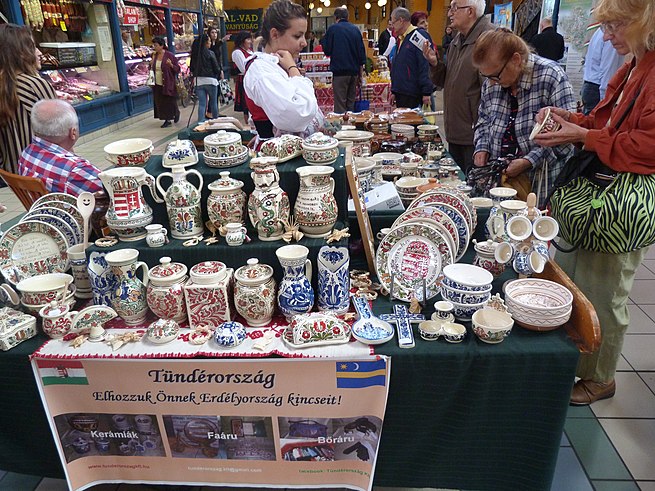
Main Difference
The main difference between Pottery and Ceramic is that the Pottery is a craft of making objects from clay and Ceramic is a inorganic, nonmetallic solid prepared by the action of heat
-
Pottery
Pottery is the process of forming vessels and other objects with clay and other ceramic materials, which are fired at high temperatures to give them a hard, durable form. Major types include earthenware, stoneware and porcelain. The place where such wares are made by a potter is also called a pottery (plural “potteries”). The definition of pottery used by the American Society for Testing and Materials (ASTM), is “all fired ceramic wares that contain clay when formed, except technical, structural, and refractory products.” In archaeology, especially of ancient and prehistoric periods, “pottery” often means vessels only, and figures etc. of the same material are called “terracottas”. Clay as a part of the materials used is required by some definitions of pottery, but this is dubious.
Pottery is one of the oldest human inventions, originating before the Neolithic period, with ceramic objects like the Gravettian culture Venus of Dolní Věstonice figurine discovered in the Czech Republic dating back to 29,000–25,000 BC, and pottery vessels that were discovered in Jiangxi, China, which date back to 18,000 BC. Early Neolithic and pre-Neolithic pottery artifacts have been found, in Jōmon Japan (10,500 BC), the Russian Far East (14,000 BC), Sub-Saharan Africa (9,400 BC), South America (9,000s-7,000s BC), and the Middle East (7,000s-6,000s BC).
Pottery is made by forming a ceramic (often clay) body into objects of a desired shape and heating them to high temperatures (600-1600 °C) in a bonfire, pit or kiln and induces reactions that lead to permanent changes including increasing the strength and rigidity of the object. Much pottery is purely utilitarian, but much can also be regarded as ceramic art. A clay body can be decorated before or after firing.
Clay-based pottery can be divided into three main groups: earthenware, stoneware and porcelain. These require increasingly more specific clay material, and increasingly higher firing temperatures. All three are made in glazed and unglazed varieties, for different purposes. All may also be decorated by various techniques. In many examples the group a piece belongs to is immediately visually apparent, but this is not always the case. The fritware of the Islamic world does not use clay, so technically falls outside these groups. Historic pottery of all these types is often grouped as either “fine” wares, relatively expensive and well-made, and following the aesthetic taste of the culture concerned, or alternatively “coarse”, “popular” “folk” or “village” wares, mostly undecorated, or simply so, and often less well-made.
-
Ceramic
A ceramic (Ancient Greek: κεραμικός — keramikós, “potter’s”, from Ancient Greek: κέραμος — kéramos, “potter’s clay”) is a solid material comprising an inorganic compound of metal, non-metal or metalloid atoms primarily held in ionic and covalent bonds. Common examples are earthenware, porcelain, and brick.
The crystallinity of ceramic materials ranges from highly oriented to semi-crystalline, vitrified, and often completely amorphous (e.g., glasses). Most often, fired ceramics are either vitrified or semi-vitrified as is the case with earthenware, stoneware, and porcelain. Varying crystallinity and electron composition in the ionic and covalent bonds cause most ceramic materials to be good thermal and electrical insulators (extensively researched in ceramic engineering). With such a large range of possible options for the composition/structure of a ceramic (e.g. nearly all of the elements, nearly all types of bonding, and all levels of crystallinity), the breadth of the subject is vast, and identifiable attributes (e.g. hardness, toughness, electrical conductivity, etc.) are difficult to specify for the group as a whole. General properties such as high melting temperature, high hardness, poor conductivity, high moduli of elasticity, chemical resistance and low ductility are the norm, with known exceptions to each of these rules (e.g. piezoelectric ceramics, glass transition temperature, superconductive ceramics, etc.). Many composites, such as fiberglass and carbon fiber, while containing ceramic materials, are not considered to be part of the ceramic family.The earliest ceramics made by humans were pottery objects (i.e. pots or vessels) or figurines made from clay, either by itself or mixed with other materials like silica, hardened and sintered in fire. Later ceramics were glazed and fired to create smooth, colored surfaces, decreasing porosity through the use of glassy, amorphous ceramic coatings on top of the crystalline ceramic substrates. Ceramics now include domestic, industrial and building products, as well as a wide range of ceramic art. In the 20th century, new ceramic materials were developed for use in advanced ceramic engineering, such as in semiconductors.
The word “ceramic” comes from the Greek word κεραμικός (keramikos), “of pottery” or “for pottery”, from κέραμος (keramos), “potter’s clay, tile, pottery”. The earliest known mention of the root “ceram-” is the Mycenaean Greek ke-ra-me-we, “workers of ceramics”, written in Linear B syllabic script. The word “ceramic” may be used as an adjective to describe a material, product or process, or it may be used as a noun, either singular, or, more commonly, as the plural noun “ceramics”.
-
Pottery (noun)
Fired ceramic wares that contain clay when formed.
“The shelves were lined with pottery of all shapes and sizes.”
-
Pottery (noun)
A potter’s shop or workshop, where pottery is made.
“I visited the old potteries and saw the pots being made.”
-
Ceramic (adjective)
made of clay and permanently hardened by heat
“a ceramic bowl”
-
Ceramic (adjective)
relating to ceramic articles
“a ceramic designer”
-
Ceramic (noun)
pots and other articles made from clay hardened by heat
“many of the painted ceramics are of native manufacture”
-
Ceramic (noun)
the art of making ceramic articles.
-
Ceramic (noun)
any non-metallic solid which remains hard when heated.
